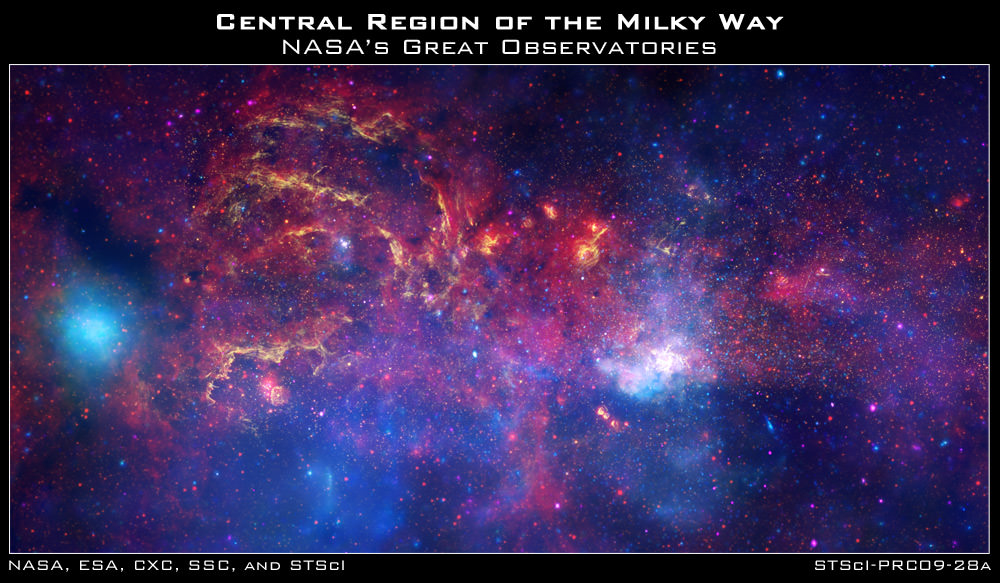All we can say is, “Wow!” In celebration of the International Year of Astronomy 2009, NASA’s Great Observatories — the Hubble Space Telescope, the Spitzer Space Telescope, and the Chandra X-ray Observatory — have collaborated to produce an unprecedented image of the central region of our Milky Way galaxy. This is a never-before-seen view of the turbulent heart of our home galaxy. The image is being unveiled by NASA to commemorate the anniversary of when Galileo first turned his telescope to the heavens in 1609. NASA provided this image and the individual images taken by each of the Great Observatories to more than 150 planetariums, museums, nature centers, libraries, and schools across the country.
In this spectacular image, observations using infrared light and X-ray light see through the obscuring dust and reveal the intense activity near the galactic core. Note that the center of the galaxy is located within the bright white region to the right of and just below the middle of the image. The entire image width covers about one-half a degree, about the same angular width as the full moon.
For more about the image or to download larger versions, go to this page on the HubbleSite.


Nancy, the disappearing image problem is occurring again.
Arrggg. Thanks for alerting me. It should be there now….(I held my tongue the right way)
Interesting to see the great increase in X-ray sources (blue stars, presumably X-ray binaries) that crowd around the nucleus. And the Paschen-alpha ‘vortex’ nebula around Sgr A-star really stands out. Great to see the wavelength mashup 🙂
Is it just me or does it rather look like a hand grasping? 🙂
Amazing Image, I do sometimes wonder however how much this is art, The telescopes collect data in wavelengths beyond the capabilities of our sight, this data is then expressed and recombined into these images.
We would probably never see this with our own eyes, Its interesting how we are using technology to transcend our biological limitations with astronomy.
Damian
It does look like a hand ! An almost skeletal right hand… That’s pretty cool.
@Nancy “Note that the center of the galaxy is located within the bright white region to the right of and just below the middle of the image.”
Can I assume that all of this white region is the x-ray activity produced by the black hole?
By enlarging the image via windows picture and fax viewer, I can make out what seems to be a “brighter” spherical white area with jets streaming from it looking somewhat like a tilted 5 point star. The jet (at about 1’oclock) looks to be “corkscrewing” out from a darker region in the “toroidal looking” sphere.
Wished I knew what I was seeing (imagining?)
You have to sit back and relax your eyes a bit to see it.
wjwbudro: I doubt that’s our black hole per se because it’s not very active right now. More than likely it’s a build-up of hot gas in the region (maybe increased star formation in that area?) Can someone more knowledgeable than I make out what that bright spot is?
From looking at the larger individual narrow-band images, the bright star-like point near Sgr A* is probably a clump of hot gas (bright in Paschen-alpha image and X-ray image) that happens to be projected near the center of our galaxy. Just a guess, though 🙂
Thanks guys. I did recall and revisited the UT blog “Near Sighted No More” April 29. X-rays generated by a young star burst nursery around Sag-A however, that “brighter” spherical concentration peeked my curiosity esp. that dark area and jet within the toroid.
Btw, is anyone really certain as to the exact location of our elusive black hole? I was certain I found it. lol
I won’t let the door slam my behind as I exit.
wjwbudro, check out the UCLA Galactic Center site (http://www.astro.ucla.edu/~ghezgroup/gc/) for some current info on actual black hole observations of Sgr A*. Links to current research papers are available at this site.
Thank you Jon for directing me to that very informative site. Wow; it’s amazing that they’ve been plotting these close-in objects for 15 years. Now if only those object designators could be superimpose onto this image. i.e. is Sgr A* (the presumed center/BH) inside what looks to be the donut hole of the “brighter” toroid/sphere in this image?
wjwbudro, although I haven’t had the time to fully read it, a paper recently appeared on the arXiv site (http://arxiv.org/abs/0911.2226) concerning Hubble’s NICMOS Paschen-alpha survey of the Galactic Center.
Lots of great, hi-res images, but IIRC, Sgr A* is located within the Paschen-alpha emission seen by Hubble. Definitely check out the paper as to the location of Sgr A* as seen with Hubble 🙂
Forgot to mention, the link will also take you to a hi-res version of the paper, so go for it.
Go for it I did and thank you. Wow, that was presented on the 11th. How do you find the time to keep abreast? I guess I wasn’t imagining after all. I was seeing what they are seeing. I haven’t thoroughly read the complete pdf presentation yet as I just got back on the net. I am hoping there is a hint at what is causing that corkscrew spiral emanating from the toroid hole.
I am truly amazed at the strides we have made at imaging. Yea for NICMOS. I am so thankful the Hubble upgrade was so successful. Just think, a couple years ago they were considering letting her die.